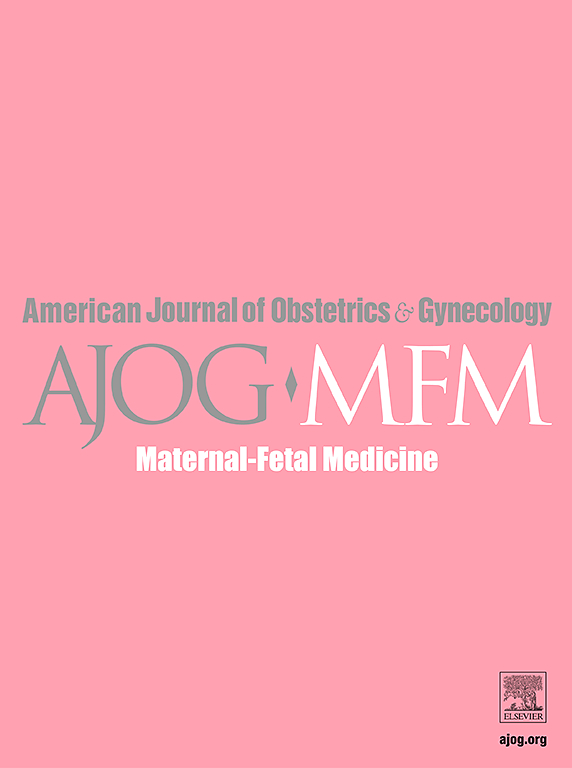Reproductive outcomes following open maternal–fetal surgery for myelomeningocele closure: analysis of MOMS trial participants
IF 3.1
2区 医学
Q1 OBSTETRICS & GYNECOLOGY
American Journal of Obstetrics & Gynecology Mfm
Pub Date : 2025-08-29
DOI:10.1016/j.ajogmf.2025.101765
引用次数: 0
Abstract
BACKGROUND
In utero closure of myelomeningocele has become an accepted alternative in the management of prenatally diagnosed spina bifida. Maternal reproductive risk has been previously described on the basis of registry data and institutional outcomes. Herein we aim to provide maternal reproductive outcomes from participants in the Management of Myelomeningocele Study.
OBJECTIVE
Open maternal–fetal surgery for in utero closure of myelomeningocele is associated with childhood benefits through school age; however, obstetrical and maternal reproductive risks are also factors to consider. The objective of this analysis was to evaluate reproductive outcomes after open maternal–fetal surgery compared with standard postnatal myelomeningocele closure.
STUDY DESIGN
The Management of Myelomeningocele Study was a randomized trial comparing prenatal vs postnatal closure of myelomeningocele. Women in the prenatal closure arm underwent open maternal–fetal surgery at 21 to 26 weeks of gestation and underwent cesarean delivery at 37 weeks if they were not delivered before that. In the postnatal closure arm, cesarean delivery was performed at 37 weeks and neonates underwent surgical closure soon after birth. Families returned for follow-up at 30 months and again at school age between 6 and 10 years. Maternal reproductive questionnaires were administered at the time of the follow-up visits to assess menstruation, fertility, gynecologic issues, and subsequent pregnancy outcomes. We compared continuous variables using the Wilcoxon test and categorical variables using the chi-square or Fisher exact test, as appropriate.
RESULTS
A total of 174 randomized women (86 in the prenatal closure group and 88 in the postnatal closure group) completed reproductive questionnaires, with 91 women reporting no subsequent pregnancies since the Management of Myelomeningocele Study. In the prenatal closure group, 36 women reported 60 subsequent pregnancies, of which 45 (75%) progressed ≥20 weeks. In the postnatal closure group, 43 women reported 71 pregnancies, of which 50 (70%) progressed ≥20 weeks. The prenatal closure group was more likely to deliver at <37 weeks (P<.001). One uterine rupture (2.2%) and 2 uterine dehiscence cases (4.4%) were reported in the prenatal closure group; none were reported in the postnatal closure group (P<.001). The use of fertility treatments or gynecologic surgeries was not different between the groups.
CONCLUSION
Preterm delivery was more common in subsequent pregnancies after open maternal–fetal surgery. The risk for uterine rupture and dehiscence was higher in the prenatal group than in the postnatal group, but lower than what has been previously reported with open maternal–fetal surgery. Reproductive outcomes were otherwise similar between women undergoing open maternal–fetal surgery for myelomeningocele closure and the postnatal closure group in the Management of Myelomeningocele Study.
脊髓脊膜膨出闭合开放母胎手术后的生殖结果:mom试验参与者的分析。
背景:子宫内髓膜膨出闭合术已成为产前诊断脊柱裂的一种可接受的治疗方法。孕产妇生殖风险以前是根据登记数据和机构结果来描述的。在这里,我们的目的是提供参与脊髓脊膜膨出管理研究的产妇生殖结果。目的:母胎开放式手术(OMFS)用于髓膜脊膜膨出(MMC)的宫内闭合与儿童期到学龄期的益处相关,但产科和孕产妇生殖风险也是需要考虑的因素。本分析的目的是评估OMFS与标准产后MMC闭合后的生殖结果。研究设计:脊髓脊膜膨出的管理研究(mom)是一项比较产前和产后MMC闭合的随机试验。产前关闭组的妇女在21-26周时接受OMFS,如果在此之前没有分娩,则在37周时剖腹产。在产后闭合组,在37周时进行剖宫产,新生儿在出生后不久进行手术闭合。这些家庭在30个月大的时候和6-10岁的学龄期间再次返回进行随访。在随访时对产妇进行生殖问卷调查,以评估月经、生育能力、妇科问题和随后的妊娠结局。我们使用Wilcoxon检验比较连续变量,使用卡方检验或Fisher精确检验比较分类变量。结果:174名随机妇女(产前关闭组86名,产后关闭组88名)完成了生殖问卷调查,其中91名妇女报告自妈妈以来没有再怀孕。在产前关闭组中,36名妇女报告了60例随访,其中45例(75%)进展≥20周。产后闭合组43名妇女报告71次妊娠,其中50例(70%)进展≥20周。产前关闭组分娩< 37周的可能性更大(p < 0.001)。产前闭合组子宫破裂1例(2.2%),子宫裂2例(4.4%);结论:早产在OMFS后的后续妊娠中更为常见。产前组子宫破裂和破裂的风险高于产后组,但低于先前报道的OMFS。在mom试验中,接受OMFS治疗MMC闭合的妇女与产后闭合组的生殖结果相似。
本文章由计算机程序翻译,如有差异,请以英文原文为准。
求助全文
约1分钟内获得全文
求助全文
来源期刊

American Journal of Obstetrics & Gynecology Mfm
Medicine-Medicine (all)
CiteScore
7.40
自引率
3.20%
发文量
254
审稿时长
40 days
期刊介绍:
The American Journal of Obstetrics and Gynecology (AJOG) is a highly esteemed publication with two companion titles. One of these is the American Journal of Obstetrics and Gynecology Maternal-Fetal Medicine (AJOG MFM), which is dedicated to the latest research in the field of maternal-fetal medicine, specifically concerning high-risk pregnancies. The journal encompasses a wide range of topics, including:
Maternal Complications: It addresses significant studies that have the potential to change clinical practice regarding complications faced by pregnant women.
Fetal Complications: The journal covers prenatal diagnosis, ultrasound, and genetic issues related to the fetus, providing insights into the management and care of fetal health.
Prenatal Care: It discusses the best practices in prenatal care to ensure the health and well-being of both the mother and the unborn child.
Intrapartum Care: It provides guidance on the care provided during the childbirth process, which is critical for the safety of both mother and baby.
Postpartum Issues: The journal also tackles issues that arise after childbirth, focusing on the postpartum period and its implications for maternal health. AJOG MFM serves as a reliable forum for peer-reviewed research, with a preference for randomized trials and meta-analyses. The goal is to equip researchers and clinicians with the most current information and evidence-based strategies to effectively manage high-risk pregnancies and to provide the best possible care for mothers and their unborn children.
 求助内容:
求助内容: 应助结果提醒方式:
应助结果提醒方式:


